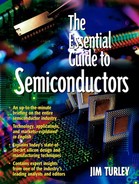Advanced Analog Components
Digital components aren't the only ones that are integrated into larger ICs. Analog components, too, have been combined in interesting ways. Some, like charge-coupled device (CCD) arrays, open up new kinds of markets and products once they're integrated. Others, like micro-electrical mechanical sensors (MEMS), seem just plain weird at first glance.
CCD Image Sensors
CCD image sensors form the basis of digital cameras and other interesting image-recognition products. A CCD image sensor is a chip with individual light sensors arranged in a square pattern, or array, like tiles on a bathroom floor. The image sensor might have 100 “tiles” across and 100 up and down, or it might have thousands in each direction. Each individual sensor in this tiled array can sense one dot, or pixel, of light. Together, they can “see” an entire image. The more sensors in the array, the sharper and clearer the image will be, which is why you'll hear camera experts bragging about how that 20-megapixel camera is better than a 3-megapixel camera.
There are other types of images sensors, such as CMOS image sensors, but they all work in basically the same way. Thousands or millions of individual light sensors are arranged in a square pattern on a chip to produce one large, clear image.
Other Sensors
Also under the heading of sensors are temperature sensors, pressure sensors, acceleration sensors, magnetic sensors, and many more. Temperature sensors are essentially electronic thermometers, useful for household thermostats as well as many industrial uses. They work by taking advantage of the way some materials behave when they get hot (or cold). Some materials conduct electricity better when they're warm or when they're cool. Engineers have discovered exactly how much their properties change and can determine the temperature of the chip by measuring how much electricity it conducts.
Magnetic sensors work in somewhat the same way. Some materials behave differently in the presence of magnetic fields, so chips built around these materials can detect slight differences in magnetism. This is useful in electronic compasses (detecting the Earth's magnetic field) or even for measuring flaws in bulk steel by sensing slight differences in its magnetic properties.
Chemistry labs and medical labs use small sensors that detect certain smells or gases. Like the temperature sensors, some materials behave differently when they're exposed to certain gases. Engineers have measured these differences and created chips that give off tell-tale electrical impulses in the presence of, say, oxygen. Like a canary in a coal mine, these chemical sensor chips can detect very minute amounts of gas or poison before laboratory technicians can.
